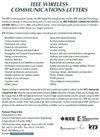Imbalanced Domain Adaptation for Automatic Modulation Classification
IF 4.6
3区 计算机科学
Q1 COMPUTER SCIENCE, INFORMATION SYSTEMS
引用次数: 0
Abstract
In non-cooperative communication, complex channel conditions can cause data distribution shift (DDS), which can significantly degrade the performance of existing automatic modulation classification (AMC) models. Initial attempts have explored the use of unsupervised domain adaptation (UDA) to mitigate this issue. However, the considerations for these works are still limited as they assume that the label distribution is domain invariant. In real-world scenarios, significant variations in the usage frequencies of different modulation types often result in imbalanced data volumes and inconsistent label distributions. This challenge, known as label distribution shift (LDS), poses a substantial challenge for cross-domain alignment. To address this limitation, this letter considers AMC in imbalanced domain adaptation (IDA) scenarios, which handle the DDS and LDS simultaneously. We propose a novel method called Pseudo label-based Imbalanced Alignment (PIA). Specifically, our PIA leverages pseudo labels in the target domain to achieve implicit and explicit conditional feature alignment, through re-weighting self-training and centroid feature alignment, respectively. We construct various IDA scenarios for experiments using custom and public datasets, and the results prove the effectiveness and superiority of PIA.用于自动调制分类的不平衡域自适应技术
在非合作通信中,复杂的信道条件会导致数据分布偏移(DDS),从而大大降低现有自动调制分类(AMC)模型的性能。最初的尝试是探索使用无监督域适应(UDA)来缓解这一问题。然而,这些工作的考虑因素仍然有限,因为它们假定标签分布是域不变的。在现实世界中,不同调制类型使用频率的显著变化往往会导致数据量的不平衡和标签分布的不一致。这种挑战被称为标签分布偏移(LDS),对跨域对齐构成了巨大的挑战。为了解决这一局限性,这封信考虑了不平衡域适应(IDA)情况下的 AMC,它可以同时处理 DDS 和 LDS。我们提出了一种称为基于伪标签的不平衡对齐(PIA)的新方法。具体来说,我们的 PIA 利用目标领域中的伪标签,通过重新加权自我训练和中心点特征对齐,分别实现隐式和显式条件特征对齐。我们利用定制数据集和公共数据集构建了各种 IDA 场景进行实验,结果证明了 PIA 的有效性和优越性。
本文章由计算机程序翻译,如有差异,请以英文原文为准。
求助全文
约1分钟内获得全文
求助全文
来源期刊

IEEE Wireless Communications Letters
Engineering-Electrical and Electronic Engineering
CiteScore
12.30
自引率
6.30%
发文量
481
期刊介绍:
IEEE Wireless Communications Letters publishes short papers in a rapid publication cycle on advances in the state-of-the-art of wireless communications. Both theoretical contributions (including new techniques, concepts, and analyses) and practical contributions (including system experiments and prototypes, and new applications) are encouraged. This journal focuses on the physical layer and the link layer of wireless communication systems.
 求助内容:
求助内容: 应助结果提醒方式:
应助结果提醒方式:


